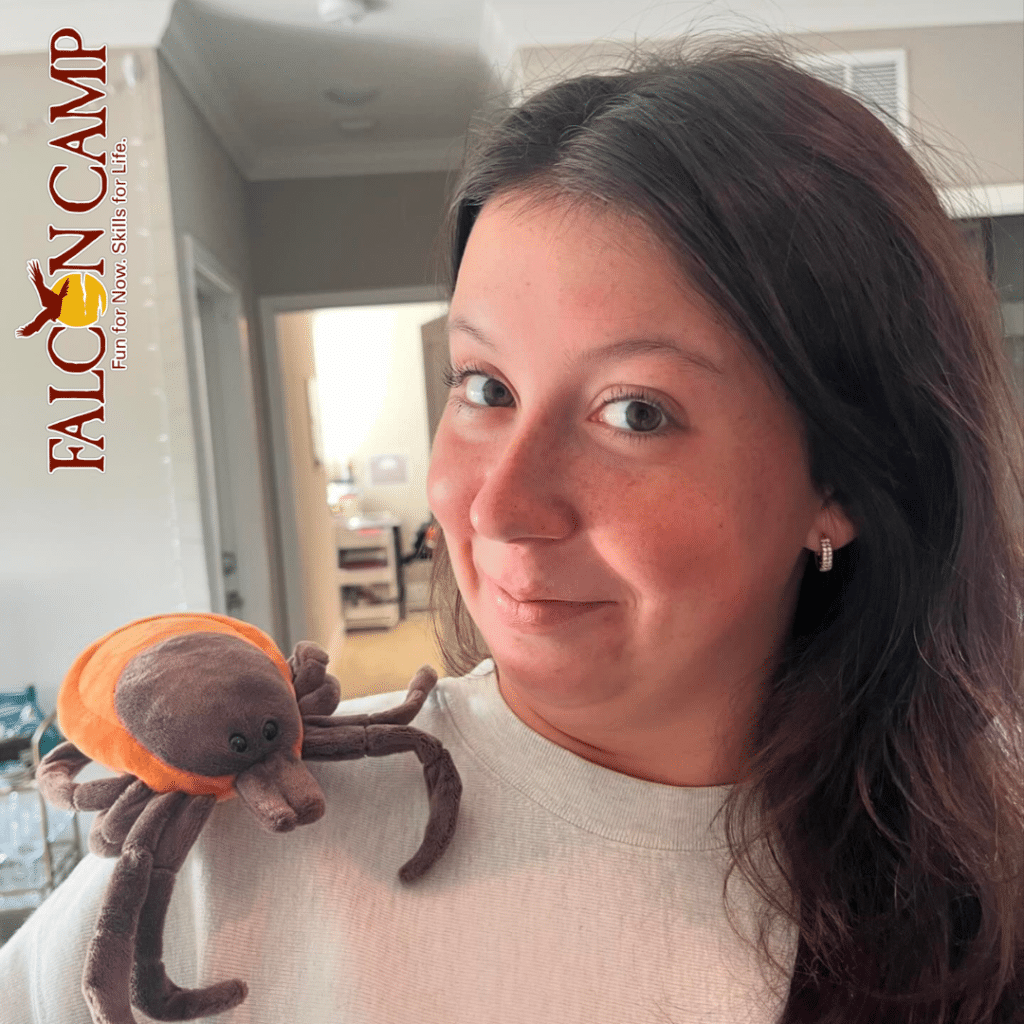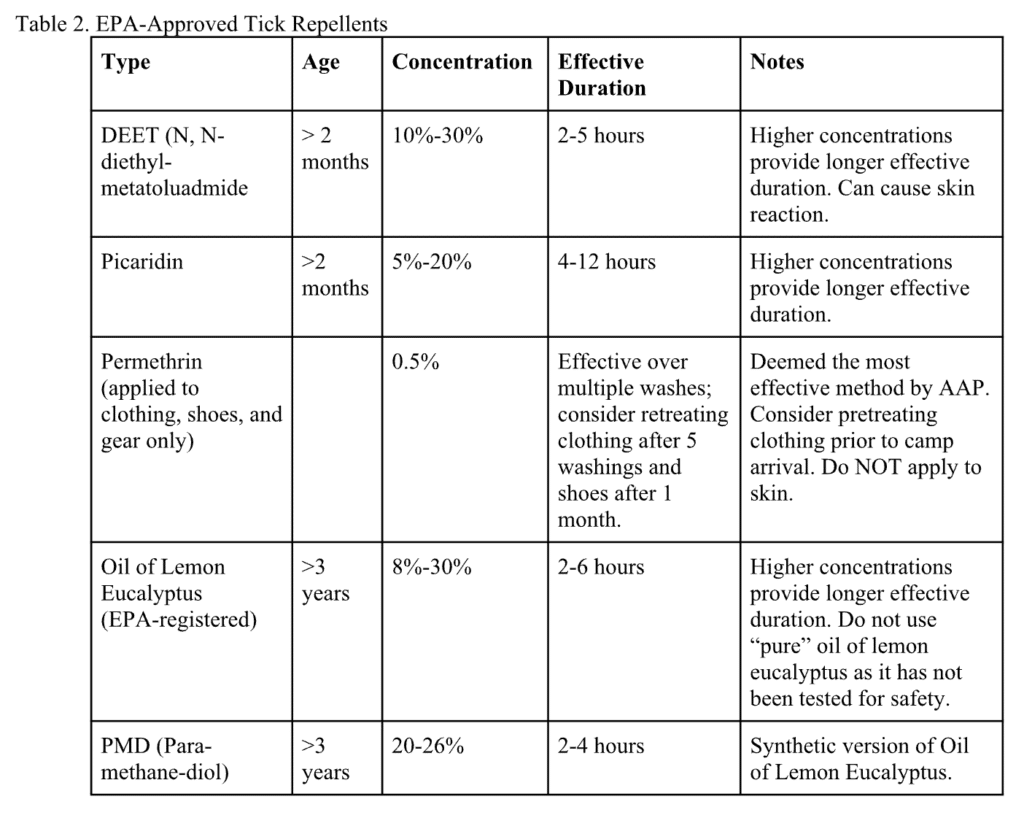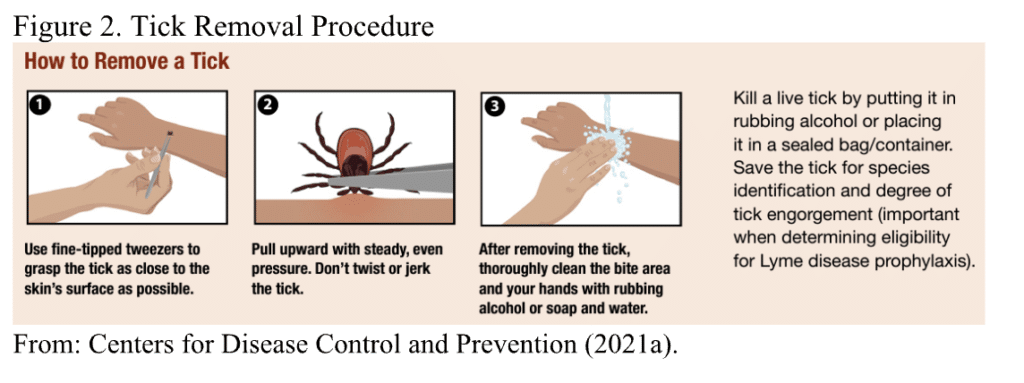Updates from Falcon on Ticks and Lyme Disease
By Lynne Rodrigues
The incidence of Lyme disease has risen exponentially over the course of the last decade (Kugeler et al., 2021). Here at Falcon, we have seen an increased number of tick bites and cases of Lyme disease among our staff and campers these last few summers. The winters have been milder which correlates directly to an increase in the tick population in the following summer. We are emerging from yet another mild winter and wanted to offer some pre-camp ideas about preventing tick bites and reducing the possibility of anyone acquiring Lyme Disease at camp as well as any other outdoor activities your family participates in this year. Preventing tick bites is the best way to reduce the incidence of Lyme disease. Research tells us, however, many people underestimate the possibility of being bitten by a tick, do not know how to best prevent tick bites, and do not know how to respond if they find an attached tick (Beaujean et al., 2013; Beck et al., 2022; Cuadera et al., 2023; Gould et al., 2008). We wanted to share steps we take as a camp staff to reduce the tick population and offer some resources to help protect your camper and your families.

As a camp staff, we take several precautions to help reduce the number of ticks around camp. Annually we do a spring clean-up to clear out the previous autumn’s fallen leaves. Reducing and eliminating leaf litter is a vital step in reducing the population of ticks and other pests at camp. In addition to finding shelter in leaf litter, ticks tend to cling to shrubbery, grass, and plants that stand two to three feet off the ground waiting for hosts to brush past them. We mow camp grass regularly to keep it short. Annually and throughout the summer, we prune back plant growth from paths and trails. Keeping a clear path for travel is another preventative technique we utilize to protect the camp community from ticks.
There are many steps individuals can take as well to decrease the likelihood of a tick bite. When possible, steer clear of brush, high grasses, and keep to the center of hiking paths. Minimize exposed skin by wearing long sleeves when possible, tucking pants into socks, and choosing light colored clothing to more easily spot ticks (CDC, 2019b). Utilizing insect repellants is a critical intervention with the power to significantly decrease the incidence of tick bites. Currently, there are 5 EPA approved options for tick/insect repellants. See Table 2 for more information on the use and efficacy of these products. Permethrin is considered the best product to eliminate ticks on clothing and ideal overall for the prevention of tick bites. Permethrin is not intended to applied to skin. It is possible to purchase clothing that has been commercially pre-treated with permethrin. Permethrin is also available for purchase with instructions for self-application to clothing at home.

If you are planning on using a repellant applied to skin, choose the lowest concentration to provide protection for the amount of time spent outside. For example, if you are planning on being outside for 2 hours, 10% DEET would be an appropriate choice. Do not apply to the face or hands in order to limit risk of eye or mouth exposure. Avoid using combination repellent/sunscreen products as sunscreen needs to be reapplied more often than repellants and could lead to overexposure. Wash hands after application
of repellent. At the end of the day, wash exposed skin with soap and water to remove the repellent. Launder clothing that has been sprayed with repellent (Balk, 2023). Always follow packaging instructions carefully (Burrows, 2018).
Another important step in preventing Lyme disease is prompt identification and removal of any tick found embedded in your skin. Please discuss and teach your camper how to inspect their bodies for ticks. Everyone should complete a careful “tick check” after being outdoors (CDC, 2019b; Erceg, 2016). Ticks will crawl on the body to find a warm, dark spot. Common spots for ticks to feed include:
- Under the arms
- In and around the ears
- Inside umbilicus
- Behind the knees
- In and around the hair
- Between the legs
- Around the waist
When checking for ticks, feel with your fingertips for any bumps on the skin. Inspect any bumps carefully as they may be a tick (CDC, 2019b). Teach your child to feel their scalp for bumps when they are washing their hair at night. At residential camps, tick checks are commonly done at the end of the day while preparing for bed (Erceg, 2016). We teach the Falcon counselors to prompt campers to check themselves for ticks as part of the cabin bedtime routine, and to assist as needed. Our counseling staff are your campers’ “parent figure” while at camp. They do monitor for proper hygiene habits and guide your camper toward independence as needed. Falcon staff is instructed to be observant of changes in the appearance of their campers. It is difficult to conduct a complete tick check independently as no one can visualize their own back, neck, and head. Observant counselors and cabinmates can help protect each other from ticks. We do support our staff and campers to help check these difficult to see areas to help each other out. (Erceg, 2016). Falcon staff and other campers have been instrumental in the past spotting ticks on each other and removing them before the person is bitten as well as spotting attached ticks during nightly tick checks ensuring quick removal.
If a tick is removed within the first 36 hours of attachment, the risk of developing Lyme Disease is substantially reduced (Lantos et al., 2021). The best, simplest method of removing an attached tick is to use a pair of fine-tipped tweezers to pull the tick straight upward with steady pressure. The illustration below shows the full method for proper removal (see Figure 2). Dispose of the tick by placing it in rubbing alcohol, flushing it in a toilet, wrapping it tightly in tape, or sealing it in a container/bag and discarding the container (CDC, 2021a).

If we remove an attached tick from your camper or minor staff member, you will be notified as soon as possible. We will share specifics such as the location of the embedded tick, the appearance of the tick, and if your child has any idea how long the tick may have been there. We ask you then call your child’s primary care provider and notify them of the tick bite. Currently, a one-dose antibiotic prophylaxis is recommended within 72 hours if the tick bite is considered “high-risk” to reduce the chance of contracting Lyme Disease (Harms et al., 2021; Lantos et al., 2021). Several factors define a tick bite as high risk (Lantos et al., 2021; Meissner & Steere, 2022; Moon, 2022):
- The tick is identified as an Ixodes/blacklegged species tick
- The tick has been attached for 36 hours or longer
- The bite occurs in a highly endemic area
- The tick is engorged when found attached
If your child’s primary care provider would like your child to have antibiotic prophylaxis, please have the physician call the antibiotic in to our local Rite Aid pharmacy. We will provide the pharmacy number for you and will go pick up your child’s medication and administer it promptly. We will continue to monitor your child at camp for any symptoms of Lyme disease if they are bitten by a tick.
Unfortunately, not all tick bites and attached ticks are recognized and found. Lyme disease is most commonly diagnosed from May-August. May to August is the time period in the tick life-cycle where nymphs (baby ticks) are at peak activity. Nymphal ticks are approximately the size of a poppy seed and are nearly impossible to see and feel. It is thought nymphal ticks may be responsible for up to 85% of all tick borne illnesses. (Be Tick Free, 2023; Beck et al., 2022; Cuadera et al., 2023) We would like to recommend you continue to monitor your child after camp for signs of Lyme disease and discuss any symptoms or concerns with your child’s primary care provider. Be certain to mention your child was living in the woods for a period this summer.
Please feel free to contact the Falcon Health Care team with any health-related questions or concerns at any time in the upcoming weeks as you prepare to send your child to camp!
Jackie Finch – nursejackie@falconcamp.com
Lynne Rodrigues – nurselynne@falconcamp.com
References
Balk, S. J. (2023, April 28). Choosing an Insect Repellent for Your Child. HealthyChildren.org; American Academy of Pediatrics. https://www.healthychildren.org/English/safety-prevention/at-play/Pages/Insect-Repellents.aspx
Be Tick Free – A Guide for Preventing Lyme Disease. (2023, July). Www.health.ny.gov. https://www.health.ny.gov/publications/2825/#:~:text=Most%20cases%20of%20Lyme%20disease
Beaujean, D. J. M. A., Bults, M., van Steenbergen, J. E., & Voeten, H. A. C. M. (2013). Study on public perceptions and protective behaviors regarding Lyme disease among the general public in the Netherlands: implications for prevention programs [Review of Study on public perceptions and protective behaviors regarding Lyme disease among the general public in the Netherlands: implications for prevention programs]. BMC Public Health, 13(225). https://doi.org/10.1186/1471-2458-13-225
Beck, A., Bjork, J., Biggerstaff, B. J., Eisen, L., Eisen, R., Foster, E., Signs, K., Tsao, J. I., Kough, E., Peterson, M., Schiffman, E., Muganda, C. P., Osborn, R., Wozniak, R., Bron, G. M., Phaneuf, D., Smith, D., Bartholomay, L., Paskewitz, S., & Hinckley, A. F. (2022). Knowledge, attitudes, and behaviors regarding tick-borne disease prevention in Lyme disease-endemic areas of the Upper Midwest, United States. Ticks and Tick-Borne Diseases, 13(3), 101925. https://doi.org/10.1016/j.ttbdis.2022.101925
Burrow, H. (2018, June 19). 9 DEET Safety Tips to Know Before You Spray. Michigan Medicine. https://www.michiganmedicine.org/health-lab/9-deet-safety-tips-know-you-spray
Center for Disease Control and Prevention. (2019a, April 22). Tick removal | CDC. Centers for Disease
Control and Prevention. https://www.cdc.gov/lyme/removal/index.html
Center for Disease Control and Prevention. (2019b, September 30). Preventing tick bites on people |
CDC. Centers for Disease Control and Prevention. https://www.cdc.gov/lyme/prev/on_people.html
Centers for Disease Control and Prevention. (2021, January 15). Signs and Symptoms of Untreated Lyme
Disease. CDC. https://www.cdc.gov/lyme/signs_symptoms/index.html
Cuadera, M. K. Q., Mader, E. M., Safi, A. G., & Harrington, L. C. (2023). Knowledge, attitudes, and practices for tick bite prevention and tick control among residents of Long Island, New York, USA. Ticks and Tick-Borne Diseases, 14(3), 102124. https://doi.org/10.1016/j.ttbdis.2023.102124
Erceg, L. (2016). Practice Updates – Summer Season Tips. Compass Point, 26(2), 17–21. www.allianceforcamphealth.org
Gould, L. H., Nelson, R. S., Griffith, K. S., Hayes, E. B., Piesman, J., Mead, P. S., & Cartter, M. L. (2008). Knowledge, Attitudes, and Behaviors Regarding Lyme Disease Prevention Among Connecticut Residents, 1999–2004. Vector-Borne and Zoonotic Diseases, 8(6), 769–776. https://doi.org/10.1089/vbz.2007.0221
Harms, M. G., Hofhuis, A., Sprong, H., Bennema, S. C., Ferreira, J. A., Fonville, M., … & Van den Wijngaard, C. C. (2021). A single dose of doxycycline after an ixodes ricinus tick bite to prevent Lyme borreliosis: An open-label randomized controlled trial. Journal of Infection, 82(1), 98-104.
Lantos, P. M., Rumbaugh, J., Bockenstedt, L. K., Falck-Ytter, Y. T., Aguero-Rosenfeld, M. E.,
Auwaerter, P. G., … & Zemel, L. S. (2021). Clinical practice guidelines by the Infectious Diseases Society of America (IDSA), American Academy of Neurology (AAN), and American College of Rheumatology (ACR): 2020 guidelines for the prevention, diagnosis and treatment of Lyme disease. Clinical Infectious Diseases, 72(1), e1-e48.
Meissner, H. C., & Steere, A. C. S., MD C. (2022). Management of Pediatric Lyme Disease: Updates
From 2020 Lyme Guidelines. Pediatrics, 149(3), 1–4. https://doi.org/https://doi.org/10.1542/peds.2021-054980
Moon, R. Y. (2022, February 10). Staying Up to Date with Guidelines for Prophylaxis and Treatment of
Pediatric Lyme Disease. American Academy of Pediatrics. https://publications.aap.org/journal-
blogs/blog/19560/Staying-Up-to-Date-with-Guidelines-for-Prophylaxis?autologincheck=redirected


